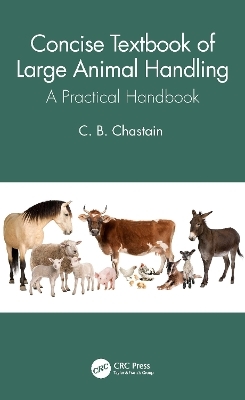
Concise Textbook of Large Animal Handling
CRC Press (Verlag)
978-0-367-62809-3 (ISBN)
This concise instructional guide condenses the most important aspects of large animal handling. It provides a portable, durable, beside-the-animal means of learning, as well as a convenient way to refresh on how to strive for safety and efficacy in animal handling techniques. It is ideal for use during veterinary placements in all settings from farm to laboratory, to riding school. The text covers:
Handler safety
Animal safety
Sanitation
Approach and capture
Routine handling and release procedures
Handling for medical procedures
Use and supply sources of restraint equipment
A Companion Website provides additional self-assessment questions and answers to aid learning.
Important reading for undergraduate veterinary students on EMS rotations, as well as practicing veterinarians, technicians, and assistants, the book covers species encountered in farm, equine, and laboratory settings.
You can hear the author discuss the topics covered in this book on his weekly podcast ‘Better Animal Handling’: https://www.betteranimalhandling.com/
C.B. Chastain is a professor emeritus and adjunct professor of veterinary medicine and former Section Head of Small Animal Medicine and Associate Dean for Academic Affairs at the University of Missouri. He also has been on faculty at Iowa State University and Louisiana State University. In addition to being a Diplomate of the American College of Veterinary Internal Medicine, he has authored journal articles, book chapters in veterinary medical and allied publications, and textbooks on clinical endocrinology and animal handling and physical restraint. Prior to entering academic veterinary medicine, he was a horse wrangler for a horseback-riding stable and a licensed guide in Rocky Mountain National Park, Colorado; worked in mixed animal veterinary medical practices in Missouri, Illinois, and New Mexico; and a captain in the U.S. Air Force Veterinary Corps. He has handled, restrained, and trained a variety of animals in differing environments and taught aspects of animal handling for more than 40 years at the undergraduate and professional school levels. Currently, he is a professor and consultant for Veterinary Online Programs at the University of Missouri.
Safer Animal Handling and Physical Restraint. Handling and Animal Welfare. Good Handling Needs Transparency. The More Effective Handler: The Art of Firm Kindness. Conditions for Handling and Restraint. Risks of Injury. Risks of Disease to Handlers and Other Animals. Ethical Concerns. Use of Force. Responsibilities for the Actions of Assistant Handlers. Legal Considerations. Roles of Chemical and Physical Restraint. Keys to Good Handling of Large Animals. Ideals and Realities. Large Animal Behavior. Behavior and Handling. Predator or Prey Behavior. Predators. Animal Hierarchy: Social Dominance. Socialization with Humans. Flight Zone and Point of Balance. Senses and Behavior. Resistance Behaviors. Species Differences in Aggression and Avoidance. Training Methods for Handling Large Animals. Health and Behavior. Stereotypic Behavior and Environmental Enrichment. Nutraceuticals and Behavior. Animal Behavior Specialists. Ropes, Knots, and Hitches. Terminology and Rope Construction. Equipment Maintenance. Equipment Safety. Useful Knots, Bends, and Hitches for Animal Handlers. Using a Lariat. Horses, Donkeys, and Mules. Natural Behavior of Horses. Safety First. Approaching, Catching, and Releasing. Handling for Routine Care and Management. Handling for Common Medical Procedures. Special Equipment. Transporting Horses. Donkeys, Mules, and Hinnies. Cattle. Natural Behavior of Cattle. Safety First. Approaching and Catching. Handling for Routine Care and Management. Handling for Common Medical Procedures. Transporting Cattle. Small Ruminants. Species Characteristics. Natural Behavior of Small Ruminants. Safety First. Sheep. Goats. South American Camelids (Llamas and Alpacas). Transporting Small Ruminants. Swine. Natural Behavior of Swine. Safety First. Approaching and Catching. Handling for Routine Care and Management. Handling for Common Medical Procedures. Transporting Swine. Poultry. Natural Behavior of Poultry. Safety First. Approaching, Catching, and Routine Handling. Handling for Common Medical Procedures. Appendix. Supply Sources of Large Animal Handling and Restraint Equipment. Multiple Species References.
| Erscheinungsdatum | 17.07.2023 |
|---|---|
| Zusatzinfo | 62 Tables, color; 72 Line drawings, color; 61 Halftones, color; 133 Illustrations, color |
| Verlagsort | London |
| Sprache | englisch |
| Maße | 156 x 234 mm |
| Gewicht | 600 g |
| Themenwelt | Naturwissenschaften ► Biologie ► Zoologie |
| Technik | |
| Weitere Fachgebiete ► Land- / Forstwirtschaft / Fischerei | |
| ISBN-10 | 0-367-62809-0 / 0367628090 |
| ISBN-13 | 978-0-367-62809-3 / 9780367628093 |
| Zustand | Neuware |
| Informationen gemäß Produktsicherheitsverordnung (GPSR) | |
| Haben Sie eine Frage zum Produkt? |
aus dem Bereich


